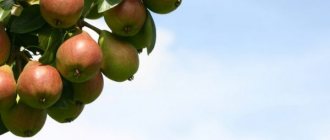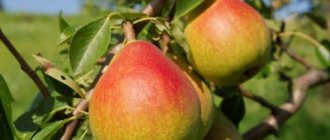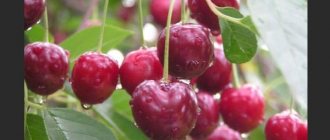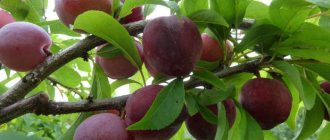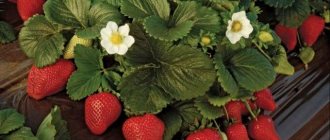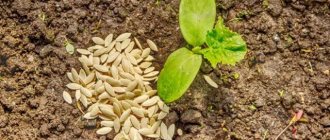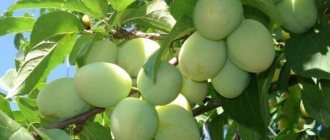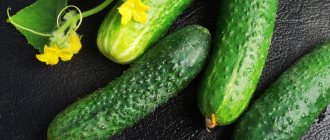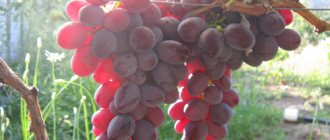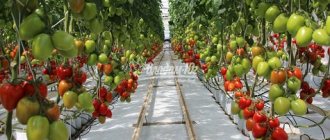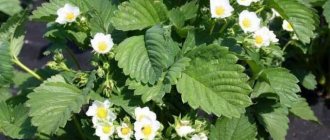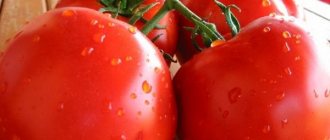Gardening » Pear
0
870
Article rating
Kira Stoletova
The Otradnenskaya pear was obtained from two species - Forest Beauty and Tyoma; it was entered into the state register in 2000. Gained popularity in the Moscow region.
Pear variety Otradnenskaya
Description of fruits
The weight of each pear is 80 - 130 g. The shape is doubly conical. The peel is smooth, without a glossy sheen. The color of the ripe fruit is yellowish-red, with a blurred blush. Inside there are 5-10 medium-sized seeds. When ripe they are dark brown in color.
The pulp is creamy white, fine-grained. The taste is weakly expressed - sweet and sour. The aroma is practically not felt.
Evaluation of the appearance of the fruit - 4 points, taste - 3.7 points.
From each mature pear it is possible to collect 30-40 kg of harvest.
Ripening occurs annually in mid-September. Collected fruits can be stored at zero temperature for 2-4 months without loss of commercial quality. Interesting! During storage, the taste of the fruit slightly improves.
Otradnenskaya pear: features of the variety and its characteristics
Official ratings for this variety are as follows: 4 for appearance and 3.7-4 for the fruits of the tree. The main advantage of the Otradnenskaya variety is its resistance to diseases, especially scab. It is also hardy to winter frosts and has a fast ripening period. The tree is self-fertile, but under cross-pollination conditions it produces a large harvest.
It is good to use varieties as a pollinator: Chizhovskaya or Lyubimitsa Yakovleva.
Description of the tree
Young specimens have a funnel-shaped shape, which changes with age and turns into a circle or oval. The branches are strewn with small leaves of rich green color. This is a standard type of tree. The pear trunk and skeletal branches are quite dark in color. The remaining shoots are covered with lighter bark.
Skeletal branches grow from the trunk at a slight angle, which is why they break from the weight of ripe fruits. The shoots of this variety are medium in size and slightly curved. The buds are brown, slightly conical in outline.
The foliage of the Otradnenskaya pear resembles an oval in contour, but slightly elongated and curved. The edge of the plate has serrations. The leaves are held on long petioles. Their upper part is smooth.
The buds are collected in inflorescences in the form of a brush. When loosened, they take on a white tint. The ovary is formed mainly on short branches.
Description of fruits
The Otradnenskaya variety begins to bear fruit at the age of 4 or 5 years. The weight of one pear does not exceed 150 g. The fruit is almost round in shape. The color of the fruit is yellow-green with a characteristic reddish side.
The fruits of this variety are distinguished by high taste and have sweet, dense pulp. Ripe pears are quite loose and fall apart in the mouth. Due to the fact that fruits are moderately hard, they can be transported over various distances.
The Otradnenskaya pear variety bears fruit consistently and has above-average yields.
Features of cultivation
Although the Otradnenskaya pear can partially self-pollinate, it requires the right proximity for full fruiting. Suitable varietals:
- "Marble";
- "Moskvichka";
- "Dressy Efimova."
Keep in mind! If it is not possible to plant other varieties on the site, neighbors’ or wild pears also have a positive effect on pollination.
First of all, a place to place the seedling is selected. The space should be open, with good lighting and ventilation. The soil can be absolutely any, the main thing is to fertilize it during planting. The best time to plant a young tree is spring. But this procedure can be performed in the fall.
Humus, ash and complex fertilizers are placed in a planting hole 80 cm deep and 100 by 80 cm in size. The roots of the seedling are carefully straightened and covered with earth.
Important! When filling a hole with soil, you need to constantly compact the soil, avoiding the formation of air cavities.
The final stage of planting is to install a peg or other support next to the pear trunk. They tie the tree with twine very carefully, in several places.
In the first year, it is very important to water the seedling regularly, avoiding drying out and waterlogging of the soil. Also, several times a season the soil around the tree is loosened.
In the spring, the next year after planting, the branches must be pruned. The shoots are shortened by about a third.
A brief excursion into history
The Otradnenskaya pear variety was obtained by the scientist-breeders of the Moscow Agricultural Academy named after K. A. Timiryazev S. T. Chizhov and S. P. Potapov, they crossed the “Tema” variety with the “Forest Beauty”.
Taster rating: 4.3 points.
The late autumn pear variety “Otradnenskaya” is included in the state register; the patent states that it is recommended for cultivation in the Central Black Earth Region.
Varieties such as “In Memory of Zhegalov”, “Tonkovetka”, “Yanvarskaya”, “Gera”, “Krasulya” are also cultivated in this territory.
Advantages and disadvantages of the variety
Advantages:
- Precociousness;
- Partial self-pollination;
- Resistance to diseases and adverse weather changes;
- Annual fruiting;
- The yield is stable and abundant (30-40 kg per tree);
- The fruits practically do not fall off the branches;
- Long-term storage at zero temperature is possible;
- Good winter hardiness.
Flaws:
- The grade is primarily for technical purposes (for processing);
- Lack of juiciness and bright aroma.
Description of the variety Otradnensky
The Otradnenskaya pear variety has medium vigor , a dark gray trunk and gray skeletal branches, thin, brown shoots, green, dark, small leaves, but strong foliage.
The buds are white, the flowers are white, collected in inflorescences of 5-7 flowers each. The fruits are elegant, 130 or 150 grams each, oval or double-cone-shaped, the variety has no tendency to fall, the yield is stable and high.
Subtleties of cultivation
An unpretentious plant that tolerates sudden temperature changes and is resistant to frost and drought does not require careful care, however, when growing the variety, you must adhere to a number of rules.
Place
For planting you need a little space, but it should be lit, with good ventilation, but without drafts.
You should not choose a place near walls, barriers and between buildings, as young seedlings will grow without forming a full-fledged crown, which will affect the amount of harvest.
Landing
The most suitable time for planting is spring, but this does not exclude planting in the fall. It should be taken into account that due to the reduced activity of the variety in growth, autumn seedlings may take root poorly and lag behind in development. When transplanting to a new location, 1-2 year old plants take root most easily.
For planting a seedling, make a hole with a diameter of 80*80cm and a depth of about 1m. The distance between them is at least 3 m.
Seedlings purchased in the fall do not have to be planted immediately. They can be buried for the winter and planted when spring arrives.
During the care process, it is necessary to ensure that the root collar of the plants is 5 cm above the surface of the soil. This provides protection against root rotting.
Description of care rules:
- abundant watering for young seedlings (reduce as they grow older to once a month);
- regular loosening of the soil;
- pruning young seedlings when planting to a meter in height, in subsequent years - by 1/3 of the length of the shoots until the tree is fully formed;
- removal of dead bark from mature trees, whitewashing of trunks.
Among the many varieties, Otradnenskaya pear is one of the most popular. It was obtained as a result of crossing Forest Beauty and Tema. Thanks to this decision of the breeders, a plant was created that, with proper care, pleases with beautiful and juicy fruits in the autumn period of the year.
Landing
Proper planting of the Otradnenskaya pear will be the key to its development throughout the long life of the tree. This includes the choice of seedling, planting site, and technology. More details about all procedures can be found in the links to the articles below.
How to plant a pear tree correctly
At what distance to plant pears?
How to choose pear seedlings
How to replant a pear
Planting and care
- Choosing a location The health of the tree, productivity, quality of fruits and its life expectancy will depend on whether you have chosen the right place for planting.
The Otradnenskaya pear variety has a low growth rate, but despite this, choose a freer place for it, with good lighting and ventilation.
With soil everything is much simpler. Insufficiently fertile soil can be fertilized and improved when planting pears. Landing
Pear trees can be planted
in both spring and autumn, but autumn planting does not guarantee good rooting and it is better to postpone planting to the spring, and bury the seedlings for the winter, placing their roots in a shallow ditch, placing the trunk and crown above the soil at an angle of 45 degrees.
The roots are dug in and covered with available material, and in the spring, after carefully inspecting them and removing possible damage, the seedlings are transferred to a permanent place.
The plant tolerates transplanting to a new place painfully; one- and two-year-old seedlings take root most easily ; the older the plant, the greater the chance of losing it.
Seedlings grown in containers can be planted in a permanent place throughout the growing season. At the location chosen for planting pears, the required number of planting holes are dug, at least a meter deep and 80 by 80 centimeters in diameter, with a distance of at least 3 meters between seedlings. Although the Otradnenskaya variety does not have great growth vigor, any pear does not tolerate thickening.
A mound is built in the center of the planting hole, the soil is slightly compacted, the roots of the seedling are evenly distributed along the slopes of the mound and gradually, evenly covered with soil with constant compaction.
Care
Otradnenskaya pear is an unpretentious variety that is very responsive to basic care. This includes watering, fertilizing and crown care procedures. You can read more about all agricultural technology using the links to the articles below.
How to care for a pear Pruning a pear Pruning a columnar pear Treating a pear from diseases and pests Feeding a pear How to water a pear
Features of planting pear seedlings of the Otradnenskaya variety
This variety can be planted twice a year. This could be in the autumn or spring months. If the seedling was grown in a container, then it can be planted at any time as long as the weather is warm.
Fruit trees planted in the autumn months grow more slowly. Therefore, experienced gardeners recommend planting pears in the spring, even if the seedling is received in the fall.
Where is the best place to plant
Important conditions for a good growing season are sufficient light and adequate air circulation. The pear tree is not very picky about soil characteristics, but if the soil is poor, then before planting the tree it is enriched with the necessary components.
It should be remembered that the seedling should be planted in an area where there are no large trees or buildings nearby.
Step by step planting process
For planting Otradnenskaya pears, only healthy young seedlings are selected. They must be free of defects. Then the dimple is prepared. Its diameter should be approximately 80 cm and its depth should be at least 1 m.
It is better to choose specimens that are less than two years old. The older the seedling, the less likely it is to be successfully planted.
The top fertile layer of soil must be carefully removed. Then mix it with mineral and organic fertilizers. Add about 10 liters of compost, 0.25 superphosphate, 3-4 “palms” of ash and 0.15 liters of potash fertilizers to the resulting substrate. A cone is formed from this soil mixture at the bottom of the hole, compacting the earth a little. Then the tree is placed so that its rhizome wraps around the cone.
The hole with the seedling is filled with the prepared mixture so that the root collar is several centimeters higher than the soil. This is very important, otherwise after irrigation and subsidence of the soil it will go underground.
Characteristics of the variety
Standard type tree, medium height. The crown is wide, with dense foliage. The bark on the trunk and main branches is dark gray. The buds deflected from the branches have a cone-shaped outline and a brown color. Thin green leaves of medium size, shaped like an egg. Their surface is smooth, without pubescence. Each cluster contains 5-7 medium-sized white flowers.
